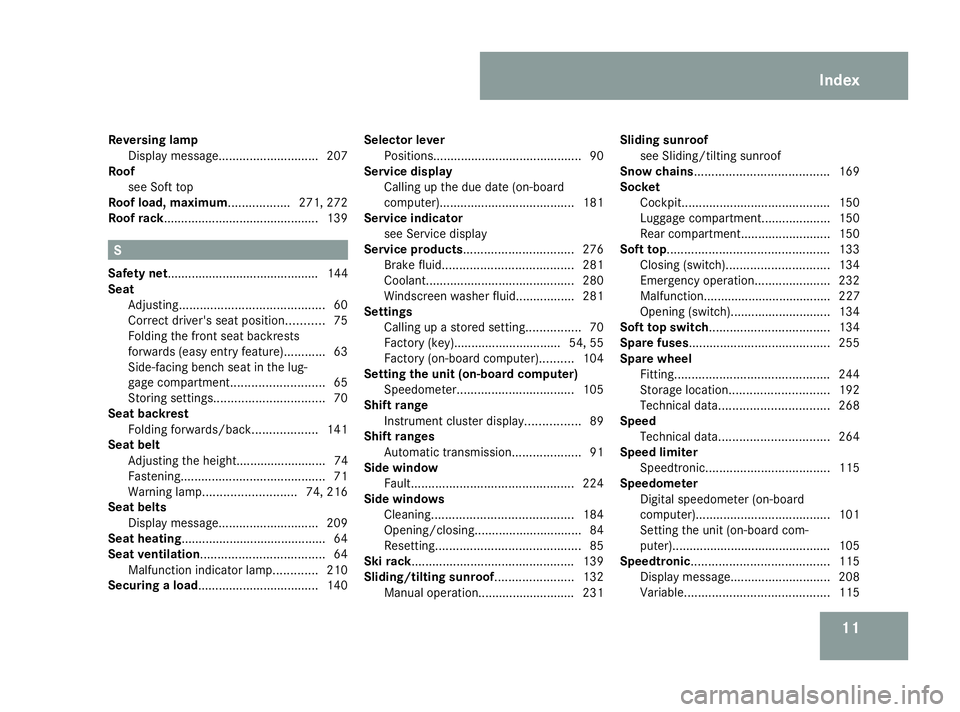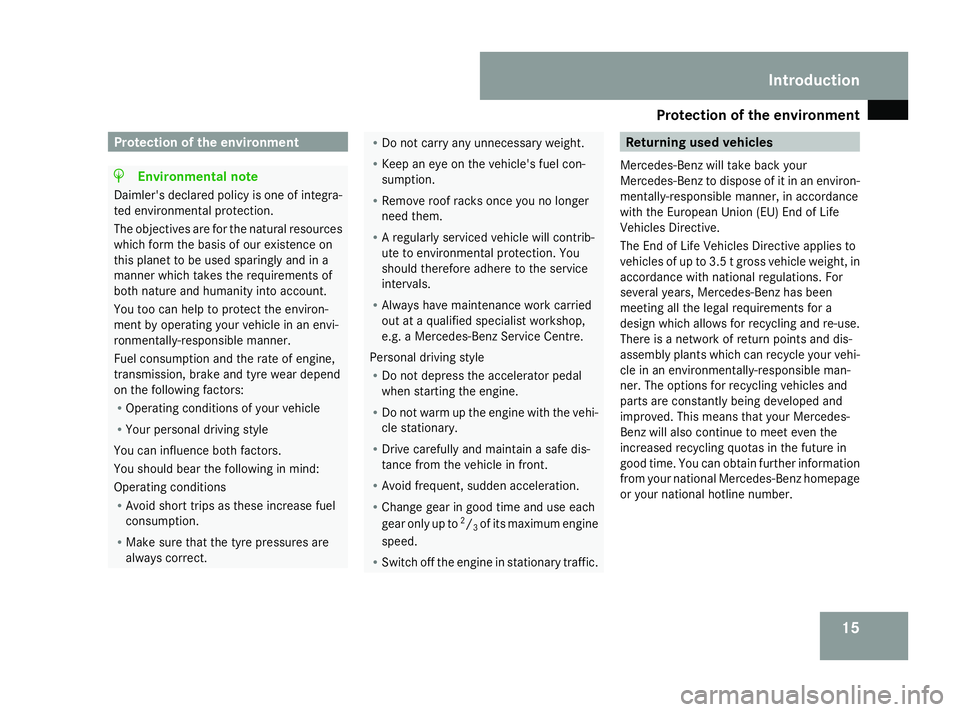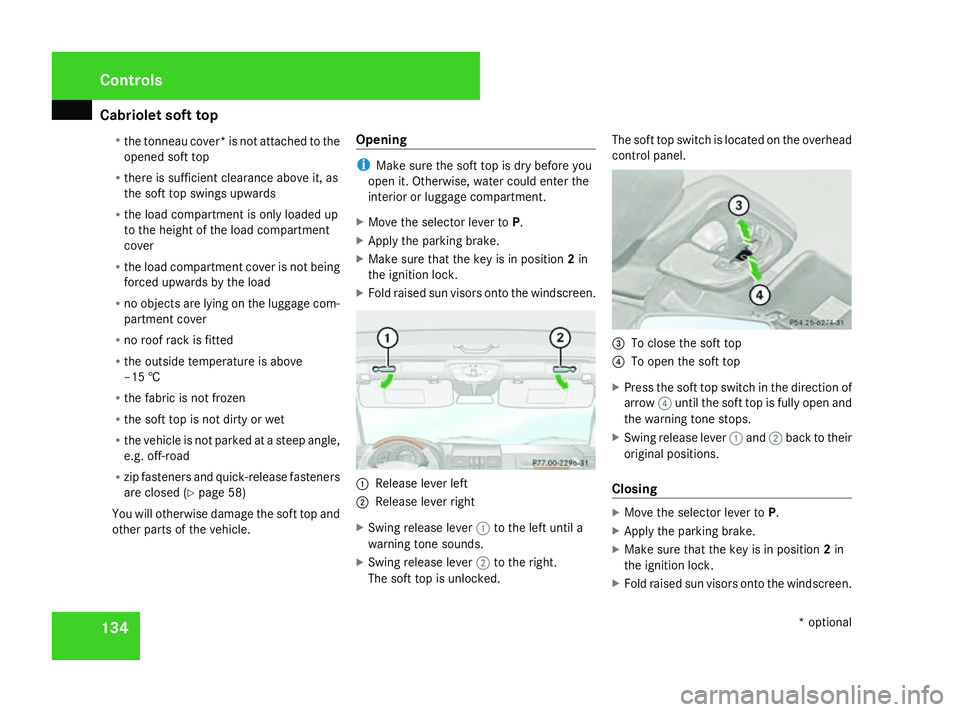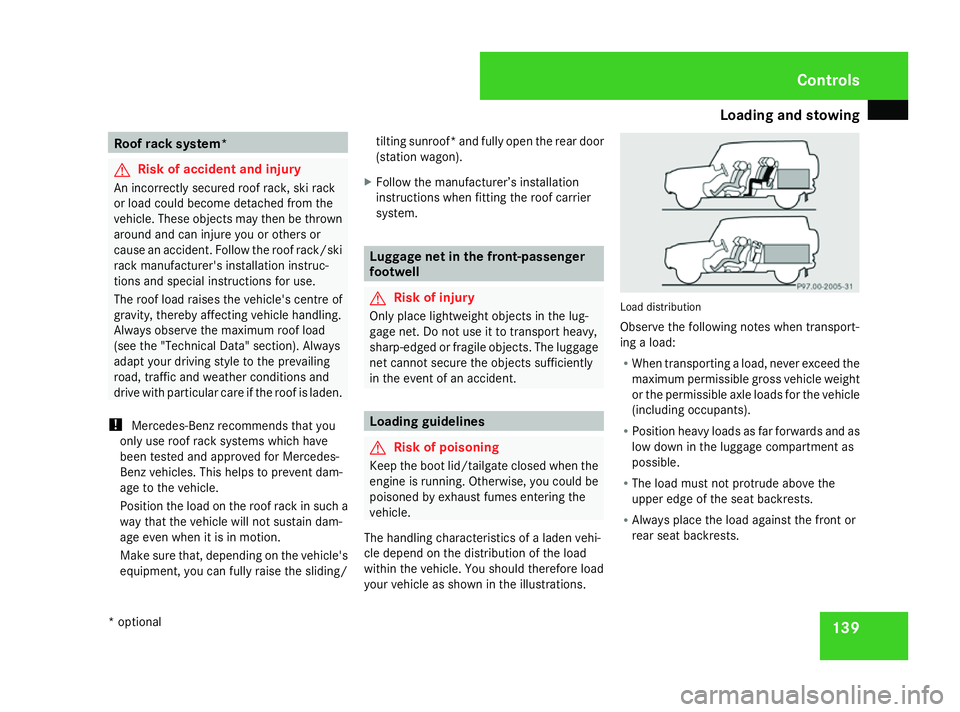roof rack MERCEDES-BENZ G-CLASS SUV 2008 Owners Manual
[x] Cancel search | Manufacturer: MERCEDES-BENZ, Model Year: 2008, Model line: G-CLASS SUV, Model: MERCEDES-BENZ G-CLASS SUV 2008Pages: 293, PDF Size: 4.49 MB
Page 14 of 293

11
Reversing lamp
Display message ............................. 207
Roof
see Soft top
Roof load, maximum.................. 271, 272
Roof rack............................................. 139S
Safety net............................................ 144
Seat Adjusting .......................................... 60
Correct driver's seat position. ..........75
Folding the front seat backrests
forwards (easy entry feature) ............63
Side-facing bench seat in the lug-
gage compartment. ..........................65
Storing settings ................................ 70
Seat backrest
Folding forwards/back. ..................141
Seat belt
Adjusting the height.......................... 74
Fastening. ......................................... 71
Warning lamp. .......................... 74, 216
Seat belts
Display message ............................. 209
Seat heating......................................... .64
Seat ventilation.................................... 64
Malfunction indicator lamp. ............210
Securing a load................................... 140Selector lever
Positions. .......................................... 90
Service display
Calling up the due date (on-board
computer). ...................................... 181
Service indicator
see Service display
Service products................................ 276
Brake fluid. ..................................... 281
Coolant. .......................................... 280
Windscreen washer fluid. ................281
Settings
Calling up a stored setting. ...............70
Factory (key). .............................. 54, 55
Factory (on-board computer). .........104
Setting the unit (on-board computer)
Speedometer. ................................. 105
Shift range
Instrument cluster display. ...............89
Shift ranges
Automatic transmission ....................91
Side window
Fault. .............................................. 224
Side windows
Cleaning. ........................................ 184
Opening/closing. .............................. 84
Resetting. ......................................... 85
Ski rack............................................... 139
Sliding/tilting sunroof....................... 132
Manual operatio n............................ 231Sliding sunroof
see Sliding/tilting sunroof
Snow chains....................................... 169
Socket Cockpit. .......................................... 150
Luggage compartment. ...................150
Rear compartment. .........................150
Soft top............................................... 133
Closing (switch). ............................. 134
Emergency operation. .....................232
Malfunction..................................... 227
Opening (switch). ............................ 134
Soft top switch................................... 134
Spare fuses......................................... 255
Spare wheel Fitting ............................................. 244
Storage location. ............................ 192
Technical data. ............................... 268
Speed
Technical data. ............................... 264
Speed limiter
Speedtronic. ................................... 115
Speedometer
Digital speedometer (on-board
computer). ...................................... 101
Setting the unit (on-board com-
puter). ............................................. 105
Speedtronic ........................................ 115
Display message ............................. 208
Variabl e.......................................... 115 Index
463_AKB; 1; 8, en-GB
wobuchh,
Version: 2.10.6 2008-07-17T15:19:41+02:00 - Seite 11Dateiname: 6515_4091_02_buchblock.pdf; preflight
Page 18 of 293

Protection of the environment
15Protection of the environment
H
Environmental note
Daimler's declared policy is one of integra-
ted environmental protection.
The objectives are for the natural resources
which form the basis of our existence on
this planet to be used sparingly and in a
manner which takes the requirements of
both nature and humanity into account.
You too can help to protect the environ-
ment by operating your vehicle in an envi-
ronmentally-responsible manner.
Fuel consumption and the rate of engine,
transmission, brake and tyre wear depend
on the following factors:
R Operating conditions of your vehicle
R Your personal driving style
You can influence both factors.
You should bear the following in mind:
Operating conditions
R Avoid short trips as these increase fuel
consumption.
R Make sure that the tyre pressures are
always correct. R
Do not carry any unnecessary weight.
R Keep an eye on the vehicle's fuel con-
sumption.
R Remove roof racks once you no longer
need them.
R A regularly serviced vehicle will contrib-
ute to environmental protection. You
should therefore adhere to the service
intervals.
R Always have maintenance work carried
out at a qualified specialist workshop,
e.g. a Mercedes-Benz Service Centre.
Personal driving style
R Do not depress the accelerator pedal
when starting the engine.
R Do not warm up the engine with the vehi-
cle stationary.
R Drive carefully and maintain a safe dis-
tance from the vehicle in front.
R Avoid frequent, sudden acceleration.
R Change gear in good time and use each
gear only up to 2
/ 3of its maximum engine
speed.
R Switch off the engine in stationary traffic. Returning used vehicles
Mercedes-Benz will take back your
Mercedes-Benz to dispose of it in an environ-
mentally-responsible manner, in accordance
with the European Union (EU) End of Life
Vehicles Directive.
The End of Life Vehicles Directive applies to
vehicles of up to 3.5 t gross vehicle weight, in
accordance with national regulations. For
several years, Mercedes-Benz has been
meeting all the legal requirements for a
design which allows for recycling and re-use.
There is a network of return points and dis-
assembly plants which can recycle your vehi-
cle in an environmentally-responsible man-
ner. The options for recycling vehicles and
parts are constantly being developed and
improved. This means that your Mercedes-
Benz will also continue to meet even the
increased recycling quotas in the future in
good time. You can obtain further information
from your national Mercedes-Benz homepage
or your national hotline number. Introduction
463_AKB; 1; 8, en-GB
wobuchh,
Version: 2.10.6 2008-07-17T15:19:41+02:00 - Seite 15 ZDateiname: 6515_4091_02_buchblock.pdf; preflight
Page 137 of 293

Cabriolet soft top
134R
the tonneau cover* is not attached to the
opened soft top
R there is sufficient clearance above it, as
the soft top swings upwards
R the load compartment is only loaded up
to the height of the load compartment
cover
R the load compartment cover is not being
forced upwards by the load
R no objects are lying on the luggage com-
partment cover
R no roof rack is fitted
R the outside temperature is above
–15 †
R the fabric is not frozen
R the soft top is not dirty or wet
R the vehicle is not parked at a steep angle,
e.g. off-road
R zip fasteners and quick-release fasteners
are closed ( Ypage 58)
You will otherwise damage the soft top and
other parts of the vehicle. Opening i
Make sure the soft top is dry before you
open it. Otherwise, water could enter the
interior or luggage compartment.
X Move the selector lever to P.
X Apply the parking brake.
X Make sure that the key is in position 2in
the ignition lock.
X Fold raised sun visors onto the windscreen. 1
Release lever left
2 Release lever right
X Swing release lever 1to the left until a
warning tone sounds.
X Swing release lever 2to the right.
The soft top is unlocked. The soft top switch is located on the overhead
control panel.
3
To close the soft top
4 To open the soft top
X Press the soft top switch in the direction of
arrow 4until the soft top is fully open and
the warning tone stops.
X Swing release lever 1and 2back to their
original positions.
Closing X
Move the selector lever to P.
X Apply the parking brake.
X Make sure that the key is in position 2in
the ignition lock.
X Fold raised sun visors onto the windscreen. Cont
rols
* optional
463_AKB; 1; 8, en-GB
wobuchh,
Version: 2.10.6 2008-07-17T15:19:41+02:00 - Seite 134Dateiname: 6515_4091_02_buchblock.pdf; preflight
Page 142 of 293

Loading and stowing
139Roof rack system*
G
Risk of accident and injury
An incorrectly secured roof rack, ski rack
or load could become detached from the
vehicle. These objects may then be thrown
around and can injure you or others or
cause an accident. Follow the roof rack/ski
rack manufacturer's installation instruc-
tions and special instructions for use.
The roof load raises the vehicle's centre of
gravity, thereby affecting vehicle handling.
Always observe the maximum roof load
(see the "Technical Data" section). Always
adapt your driving style to the prevailing
road, traffic and weather conditions and
drive with particular care if the roof is laden.
! Mercedes-Benz recommends that you
only use roof rack systems which have
been tested and approved for Mercedes-
Benz vehicles. This helps to prevent dam-
age to the vehicle.
Position the load on the roof rack in such a
way that the vehicle will not sustain dam-
age even when it is in motion.
Make sure that, depending on the vehicle's
equipment, you can fully raise the sliding/ tilting sunroof* and fully open the rear door
(station wagon).
X Follow the manufacturer’s installation
instructions when fitting the roof carrier
system. Luggage net in the front-passenger
footwell G
Risk of injury
Only place lightweight objects in the lug-
gage net. Do not use it to transport heavy,
sharp-edged or fragile objects. The luggage
net cannot secure the objects sufficiently
in the event of an accident. Loading guidelines
G
Risk of poisoning
Keep the boot lid/tailgate closed when the
engine is running. Otherwise, you could be
poisoned by exhaust fumes entering the
vehicle.
The handling characteristics of a laden vehi-
cle depend on the distribution of the load
within the vehicle. You should therefore load
your vehicle as shown in the illustrations. Load distribution
Observe the following notes when transport-
ing a load:
R When transporting a load, never exceed the
maximum permissible gross vehicle weight
or the permissible axle loads for the vehicle
(including occupants).
R Position heavy loads as far forwards and as
low down in the luggage compartment as
possible.
R The load must not protrude above the
upper edge of the seat backrests.
R Always place the load against the front or
rear seat backrests. Controls
* optional
463_AKB; 1; 8, en-GB
wobuchh,
Version: 2.10.6 2008-07-17T15:19:41+02:00 - Seite 139 ZDateiname: 6515_4091_02_buchblock.pdf; preflight